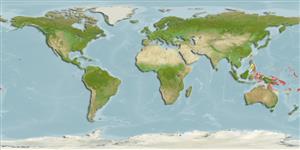Classification / Names
Common names | Synonyms | Catalog of Fishes (gen., sp.) | ITIS | CoL | WoRMS | Cloffa
Actinopterygii (ray-finned fishes) >
Ophidiiformes (Cusk eels) >
Bythitidae (Viviparous brotulas) > Brosmophycinae
Etymology: Diancistrus: Greek, di = two + Greek, agkistron = hook (Ref. 45335); eremitus: Named for the type locality's Latin translation, 'eremitus' for Hermit.. More on author: Schwarzhans, Nielsen.
Environment / Climate / Range
Ecology
Marine; pelagic-neritic; depth range 0 - 16 m (Ref. 57884). Tropical, preferred ?
Western Central Pacific: New Guinea-Solomon Island chain; off western Fiji.
Size / Weight / Age
Maturity: Lm ? range ? - ? cm
Max length : 8.3 cm SL male/unsexed; (Ref. 57884)
Short description
Morphology | Morphometrics
Dorsal
soft rays
(total): 83-86;
Anal
soft rays: 66 - 71;
Vertebrae: 42 - 44. The species is characterized by the following: vertebrae 11+31-33=42-44, dorsal fin rays 83-86, anal fin rays 66-71; eyes very large (?3.0% SL), D/V 5-6; the outer pseudoclasper is large, more than 2 times the length of inner pseudoclasper, wing-shaped, with broad base and slightly concave pointed tip without a fleshy bulge; inner pseudoclasper joined to outer pseudoclasper anteriorly, thin, with single pointed tip, short, not extending over anterior part of outer pseudoclasper; moderately broad scale patch on cheek with 5-6 scale rows on upper cheek, small scale patch on operculum above opercular spine (4-5 scales in 2 rows); head massive; otolith moderately slender, length to height 1.9-2.0 (Ref. 57884).
Solitary inhabitant of coral reef crevices, cryptic (Ref 90102).
Life cycle and mating behavior
Maturity | Reproduction | Spawning | Eggs | Fecundity | Larvae
Schwarzhans, W., P.R. Møller and J.G. Nielsen, 2005. Review of the Dinematichthyini (Teleostei, Bythitidae) of the Indo-West-Pacific. Part I. Diancistrus and two new genera with 26 new species. The Beagle, Records of the Museum and Art Galleries of the Northern Territory 21:73-163. (Ref. 57884)
IUCN Red List Status (Ref. 115185)
CITES (Ref. 94142)
Not Evaluated
Threat to humans
Harmless
Human uses
More information
Common namesSynonymsMetabolismPredatorsEcotoxicologyReproductionMaturitySpawningFecundityEggsEgg development
Age/SizeGrowthLength-weightLength-lengthLength-frequenciesMorphometricsMorphologyLarvaeLarval dynamicsRecruitmentAbundance
ReferencesAquacultureAquaculture profileStrainsGeneticsAllele frequenciesHeritabilityDiseasesProcessingMass conversion
Tools
Special reports
Download XML
Internet sources
Estimates of some properties based on models
Phylogenetic diversity index (Ref.
82805): PD
50 = 0.5000 [Uniqueness, from 0.5 = low to 2.0 = high].
Bayesian length-weight: a=0.00447 (0.00175 - 0.01142), b=3.10 (2.88 - 3.32), in cm Total Length, based on LWR estimates for this (Sub)family-body shape (Ref.
93245).
Trophic Level (Ref.
69278): 3.2 ±0.5 se; Based on size and trophs of closest relatives
Resilience (Ref.
69278): High, minimum population doubling time less than 15 months (Preliminary K or Fecundity.).
Vulnerability (Ref.
59153): Low vulnerability (15 of 100) .
